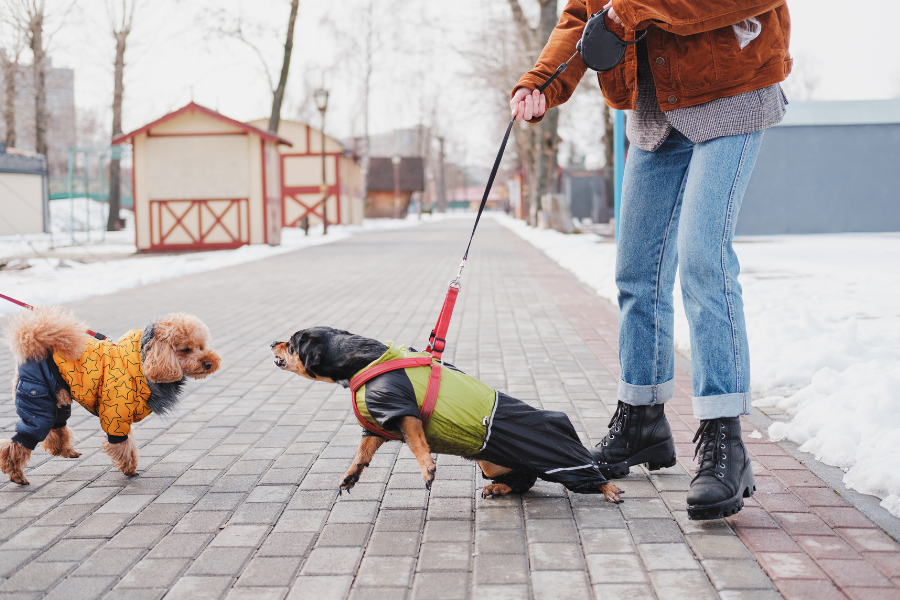For all of us with four-legged buddies, we realize they are more than just pets, they are our fam! And just like any family member, their behaviors, personality, and biology are all different. They can run the gamut from outgoing to shy, obedient to willful, or, in the case of some, from trusty sidekick to...well, that guy down the street who loses his sh** every time a group of boys on skateboards go by. Yes, we're talking about reactive dogs.
Reactivity in dogs can be a bit puzzling for pet parents. Sometimes it can present as fear or overexcitement or stress. In this article, we're not only going to decode what exactly a reactive dog is, but we'll share invaluable insights on training your pup to curb those less than adorable outbursts. Whether you're dealing with a new arrival to the family whose jumpy joie de vivre is getting a bit out of hand, or have an old-timer who's been barking at strangers since flip phones were in vogue, you'll find this information invaluable.
Defining Dog Reactivity
At its core, reactivity is an overreaction that's typically triggered by something in the environment – a dog, a person, even a bicycle. The most common form is fear-based, where a dog perceives a threat and acts to protect itself by either lunging and barking (or growling) to drive the perceived threat away, or, if the threat cannot leave, to create distance by trying to snap or bite. Aggressive reactivity is rarer, where the dog's intention is to cause harm.
The key with reactivity is to understand that for our furry friends, this over-the-top behavior isn't due to them being 'bad dogs.' It's often an emotional response to something they don't understand or can't predict. And, just as you wouldn't shout at a child who's scared or stressed, the best approach to help them is through calm, understanding, and well-informed training.
Identifying Triggers and Thresholds
The first, and maybe the most important step in taming reactivity in a dog is identifying what it is that is setting them off, how intense is this stimulus must be, and for what duration? For example, some dogs may only react when the triggering stimulus is quite close or sudden, while others might react if they perceive the trigger from a distance.
To establish these thresholds, observe your dog in various environments and note their body language when they see a potential trigger. Is their tail between their legs? Are they cowering? Or do they stiffen up? Once you know what cues to look for, you'll be better equipped to begin training.
Implementing Positive Reinforcement
If you determine that your dog's reactivity is fear-based, then an antidote can be building - albeit slowly - positive associations with that stimulus. This means associating the presence of the trigger with something your dog loves – most commonly, treats. You can begin by rewarding your pup for being calm and not reacting when the trigger is present. This could involve 'counter-conditioning', which is essentially trying to replace the negative emotion associated with the trigger with a positive one.
For instance, if your dog typically reacts when they see another dog, start training by rewarding them for simply noticing the dog and then gradually increasing the expectation, so your dog is eventually rewarded for not reacting even when the other dog is quite close. Remember, the timing of the treat is crucial – it should occur when they're near the trigger, not once they've begun the undesirable behavior, as you don't want to inadvertently reward the reaction.
Desensitization: Slow and Steady Exposure
Desensitization involves gradually exposing your dog to the trigger in a controlled, progressive way that allows them to remain below their reactive threshold. Over time, with repetition, the hope is that the dog becomes 'desensitized' to the once-aversive stimulus. This training process can take significant time and dedication, but it's an effective way of dealing with reactivity.
Start by introducing the trigger at a distance that doesn't elicit a reaction, then slightly decrease that distance with each session as long as your dog stays calm. If at any point they show signs of reactivity, it’s a cue to back off and decrease the intensity. Always end on a positive note, even if that means stepping back and giving a reward for a less intense exposure.
Training with Distractions
Reactivity often rears its head in the face of distractions, which can make training outside the controlled environment of your home a real challenge. But by incorporating distractions into your training routine, you're preparing your dog for more realistic circumstances.
These distractions can range from simple obedience commands like 'sit' and 'stay' to more engaging activities like walking near a playground where children are playing. The key is repetition and consistency – the more your dog can remain calm in the face of these distractions during training, the better equipped they'll be in everyday life.
Stay Patient and Consistent
There's no one-size-fits-all solution to dog reactivity. Each dog is different, and what works for one might not work for another. The training process can be slow, with progress often coming in small, almost imperceptible steps. But with patience, consistency, and lots of love, you can help your reactive pup become their best, calm and confident canine self.
Remember, reactive dogs are not 'bad' dogs. They might require different training and understanding, but the bond that you form with them through this process can be incredibly rewarding. When you see the hard work paying off and your pup responding positively to training, it's a heartwarming validation of your dedication.
Professional Support
For extreme cases of dog reactivity, finding a professional can be the best route. There are plenty of skilled dog-trainers out there, from household names like Cesar Milan (AKA the Dog Whisperer), to more niche dog-behavior specialists. If you're in the NYC area, reach our to our team fav, Lee Cahill, who has a depth of knowledge and experience she has built over years of training dogs of all types. Trainers like Lee can help create a customized training plan that suits your dog’s unique needs and work directly with you to instill the right behaviors and responses.
Training a reactive dog requires a team approach. You, as the owner, will need to be the leader of that team, guiding your pup through a transformation that is both educational and emotional. But with the right techniques and a commitment to consistent training, you can improve your dog's reactivity and foster a happier and more harmonious relationship between you and your beloved pet.
The Final Paw
Dog reactivity isn't a life sentence (we hope), not for your pup, for you, or or for the quality of your bond with them. Through research, understanding, patience, and a strategic training plan (if needed), you can help your reactive dog feel more at ease in the world and more confident in their place in it. Remember, training - like life - is process, and every small step forward is a victory worth celebrating and reinforcing. Your dog might not be perfect (no human or pet is), but they are perfect for you, reactive idiosyncrasies and all.



